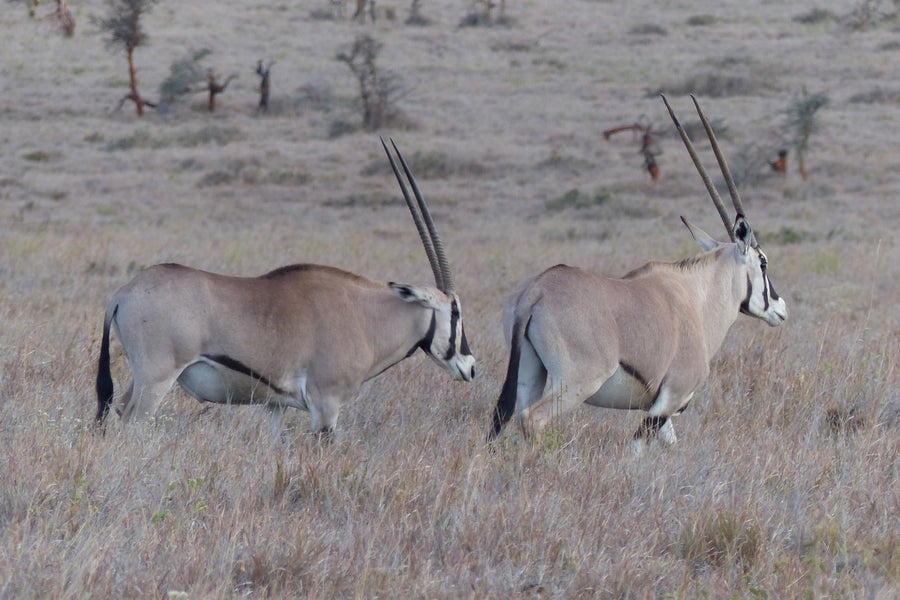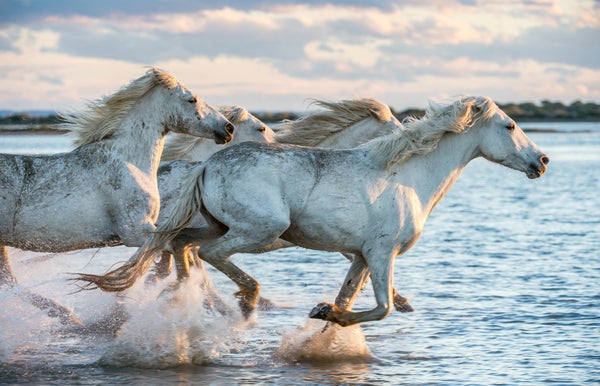Males Aren’t Larger Than Females in Most Mammalian Species
Males Aren’t Larger Than Females in Most Mammalian Species
A new study corrects a biased assumption promoted by Charles Darwin 150 years ago and repeated ever since
In The Descent of Man, Charles Darwin posits that in most species of mammals, males are larger than females. Although Darwin did not cite evidence to back up this claim, his view on sexual size dimorphism was readily accepted as fact, and it still dominates today.
But Darwin, in this case, seems to have been wrong. An analysis of 429 mammalian species published in Nature Communications reveals that just 45 percent feature males that are larger than females. Nearly an equal number of species, 39 percent, have sexes that are about the same size. And in 16 percent of species, females are larger than males.
“There’s been this really strong inertia toward the larger male narrative, but it was just based on Darwin’s hand-wavy statement, and the evidence doesn’t really support it,” says the study’s lead author Kaia Tombak, a postdoctoral evolutionary biologist at Purdue University. That this narrative has endured for so long “may reflect Western societal biases that tend to look at issues through a male lens.”
On supporting science journalism
If you’re enjoying this article, consider supporting our award-winning journalism by subscribing. By purchasing a subscription you are helping to ensure the future of impactful stories about the discoveries and ideas shaping our world today.

Two beisa oryx wandering the plains in Kenya. While the males of most bovid species are larger than females, beisa oryx do not differ very much in size, and both sexes have horns.
Tombak found herself conducting the new study by chance after she and some other researchers in an online seminar began debating the factors that shape male and female aggressiveness in species whose sexes are the same size. No one knew the answer, so Tombak decided to look into it. But she quickly realized she’d have to deal with another problem first: a lack of reliable data about how many species actually have males and females of the same size. Her hunt for answers turned into a nearly three-year-long “COVID passion project,” she says, which she conducted during her previous position as a postdoc at Hunter College of the City University of New York.
Most past studies that compared male and female size, Tombak found, only considered the average body mass for each of the sexes. The authors then drew conclusions based on whatever cutoff they set for determining if there was a difference. “It was just arbitrary,” Tombak says. Virtually all of these papers reinforced Darwin’s view that males are larger than females in mammalian species.
Tombak and her colleagues did find one paper that clearly bucked the trend in terms of the conclusions its author came to: a study from 1976 by biologist Katherine Ralls. She looked at size patterns across mammalian taxa and found that most species did not exhibit extreme sexual size dimorphism and that larger females were surprisingly common as well. Her findings, however, were frequently either overlooked or misconstrued, Tombak says. “By then, the narrative about larger males had been around for 100 years, so it kept going,” she adds.
Tombak and her colleagues started filling in the gaps by conducting a thorough literature review, oftentimes turning to “obscure” papers published decades ago, she says. They were looking for not just averages pertaining to the sexes’ sizes but also measures of variance around the mean so they could apply statistical tests to determine whether a species truly seemed to be dimorphic.
Most past research on this topic has also been biased toward charismatic species such as carnivores, primates and ungulates, Tombak found. She and her colleagues corrected for this by sampling 5 percent of species across each of 16 mammalian orders that contained at least 10 species each, groups that ranged from bats to rodents. They also sampled 3.8 percent of species in an additional order, Eulipotyphla, which includes moles, shrews and hedgehogs.
The study results indicate that there are nearly as many mammalian species that have similarly sized males and females as there are species that have larger males. That observation raises the question of why this is the case, Tombak says.
In the 1970s Ralls tried to explain it by putting forward the “big mother” hypothesis, or the idea that larger females might be more capable of producing successful offspring. This still needs to be explored, however.
What can be said for sure, though, is that the new findings will influence “the direction of future research and what kind of questions should be pursued,” says Malin Ah-King, an evolutionary biologist at Stockholm University, who was not involved in the research.
“The questioning and reevaluation of prevailing assumptions about sex differences is part of an ongoing process that I call the female turn,” she says. “Perceptions about females have [changed] and are still changing away from passive, coy and mating with one male—and now, in mammals, being generally smaller than males.”
Males Aren’t Larger Than Females in Most Mammalian Species
A new study corrects a biased assumption promoted by Charles Darwin 150 years ago and repeated ever since

In The Descent of Man, Charles Darwin posits that in most species of mammals, males are larger than females. Although Darwin did not cite evidence to back up this claim, his view on sexual size dimorphism was readily accepted as fact, and it still dominates today.
But Darwin, in this case, seems to have been wrong. An analysis of 429 mammalian species published in Nature Communications reveals that just 45 percent feature males that are larger than females. Nearly an equal number of species, 39 percent, have sexes that are about the same size. And in 16 percent of species, females are larger than males.
“There’s been this really strong inertia toward the larger male narrative, but it was just based on Darwin’s hand-wavy statement, and the evidence doesn’t really support it,” says the study’s lead author Kaia Tombak, a postdoctoral evolutionary biologist at Purdue University. That this narrative has endured for so long “may reflect Western societal biases that tend to look at issues through a male lens.”
On supporting science journalism
If you’re enjoying this article, consider supporting our award-winning journalism by subscribing. By purchasing a subscription you are helping to ensure the future of impactful stories about the discoveries and ideas shaping our world today.

Two beisa oryx wandering the plains in Kenya. While the males of most bovid species are larger than females, beisa oryx do not differ very much in size, and both sexes have horns.
Tombak found herself conducting the new study by chance after she and some other researchers in an online seminar began debating the factors that shape male and female aggressiveness in species whose sexes are the same size. No one knew the answer, so Tombak decided to look into it. But she quickly realized she’d have to deal with another problem first: a lack of reliable data about how many species actually have males and females of the same size. Her hunt for answers turned into a nearly three-year-long “COVID passion project,” she says, which she conducted during her previous position as a postdoc at Hunter College of the City University of New York.
Most past studies that compared male and female size, Tombak found, only considered the average body mass for each of the sexes. The authors then drew conclusions based on whatever cutoff they set for determining if there was a difference. “It was just arbitrary,” Tombak says. Virtually all of these papers reinforced Darwin’s view that males are larger than females in mammalian species.
Tombak and her colleagues did find one paper that clearly bucked the trend in terms of the conclusions its author came to: a study from 1976 by biologist Katherine Ralls. She looked at size patterns across mammalian taxa and found that most species did not exhibit extreme sexual size dimorphism and that larger females were surprisingly common as well. Her findings, however, were frequently either overlooked or misconstrued, Tombak says. “By then, the narrative about larger males had been around for 100 years, so it kept going,” she adds.
Tombak and her colleagues started filling in the gaps by conducting a thorough literature review, oftentimes turning to “obscure” papers published decades ago, she says. They were looking for not just averages pertaining to the sexes’ sizes but also measures of variance around the mean so they could apply statistical tests to determine whether a species truly seemed to be dimorphic.
Most past research on this topic has also been biased toward charismatic species such as carnivores, primates and ungulates, Tombak found. She and her colleagues corrected for this by sampling 5 percent of species across each of 16 mammalian orders that contained at least 10 species each, groups that ranged from bats to rodents. They also sampled 3.8 percent of species in an additional order, Eulipotyphla, which includes moles, shrews and hedgehogs.
The study results indicate that there are nearly as many mammalian species that have similarly sized males and females as there are species that have larger males. That observation raises the question of why this is the case, Tombak says.
In the 1970s Ralls tried to explain it by putting forward the “big mother” hypothesis, or the idea that larger females might be more capable of producing successful offspring. This still needs to be explored, however.
What can be said for sure, though, is that the new findings will influence “the direction of future research and what kind of questions should be pursued,” says Malin Ah-King, an evolutionary biologist at Stockholm University, who was not involved in the research.
“The questioning and reevaluation of prevailing assumptions about sex differences is part of an ongoing process that I call the female turn,” she says. “Perceptions about females have [changed] and are still changing away from passive, coy and mating with one male—and now, in mammals, being generally smaller than males.”
